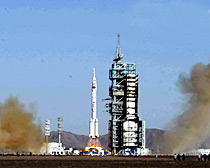
China's first astronaut, Yang Liwei, 38, was hurled into outer
space by Shenzhou V spacecraft at 9 a.m. Wednesday from Jiuquan
Satellite Launch Center in northwest China's Gansu Province.
Amidst deafening roars, the Shenzhou V manned spacecraft was
lifted into the sky by a Long March-II-F carrier rocket. Both the
spacecraft and the carrier rocket were designed and built by China
independently.
Li Jinai, director-general of China's manned space program,
announced success of the launch about ten minutes after the
blast-off, when the spacecraft entered its preset orbit with
precision.
This, China's maiden manned space flight is scheduled to last 21
hours. Success of its launch means that China has become the third
country capable of sending people into outer space, following the
United States and Russia.
"Today, our long-held manned space flight dream has finally come
true," said Hu Shixiang, vice director-general of China's manned
space program.
The Chinese people's space dream could be traced to a fairy tale
that has been told since ancient time, about a woman of surpassing
beauty flying to the moon after taking some magic medicine, where
she stays as the Moon Goddess.
Back in the 14th century, a Chinese named Wan Hu attempted to
send himself into sky by lighting 47 gunpowder-packed bamboo tubes
tied to his chair. Although he got killed in this bold attempt, Wan
has since been widely regarded as the world's first person using
rockets as a flight vehicle.
Thirty-three years ago, Hu Shixiang pressed the rocket blast-off
button to send China's first man-made satellite into space. China's
space exploration activities had since started.
Five years later, with the successful landing of the country's
first recoverable satellite, China turned out to be the third
nation in the world having acquired the space vehicle recovery
technology. "This laid a solid foundation for China's manned
spaceflight program", said Wang Yongzhi, chief designer of China's
manned space program.
"The successful launch of Shenzhou V proves that China's space
technology has advanced from the research phase into the
application phase," said Gu Yidong, director-general and chief
designer of the space application system under China's manned space
program.
Since China officially launched its manned space program in
1992, its experts have resolved a range of technical problems with
the astronaut system, space application system, spacecraft system,
rocket system and launch pad system.
Between 1999 and 2002, China successfully launched four
experimental and unmanned spacecraft, paving the way for this
manned flight. The Jiuquan Satellite Launch Center, located at the
juncture area of the Badain Jardan Desert and the Gobi Desert in
northwest China's Gansu Province, is the country's largest
spaceport from which all the previous four spacecraft were
launched.
Yang is expected to land somewhere on the grassland in the
central part of Inner Mongolia Autonomous Region, north China,
after orbiting the Earth 14 times.
Before being selected as the member of China's first batch of
would-be astronauts, Yang, a native of Suizhong County, northeast
China's Liaoning Province, is a veteran fighter pilot of the
People's Liberation Army (PLA) air force whose flight experience
reached 1,350 hours.
In 1998, Yang and 13 other PLA fighter pilots were selected from
1,500 candidates to form the country's first team of would-be
astronauts.
Su Shuangning, director-general of the astronaut system under
China's manned space program, noted that all would-be astronauts
have become capable of working and living in space after receiving
tough physical, psychological and technical training in the past
five years.
Gu Yidong told Xinhua that the manned space program's ultimate
goal for China was to explore outer space and make a good use of
the rich resources of space.
Gu said human civilization is moving forward step by step with
mankind's domain expanding gradually from land to ocean, to sky and
finally to outer space, adding that outer space exploration has
turned out to be an important driving force for mankind's economic
and social development.
(Xinhua News Agency October 15, 2003)

